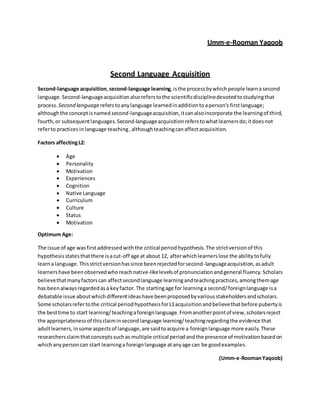
Second Language Acquisiton
- 1. Umm-e-Rooman Yaqoob Second Language Acquisition Second-language acquisition,second-language learning,isthe processbywhichpeople learna second language.Second-languageacquisition alsoreferstothe scientificdisciplinedevotedtostudyingthat process. Second languagereferstoanylanguage learnedinadditiontoaperson's firstlanguage; althoughthe conceptisnamed second-languageacquisition,itcanalsoincorporate the learningof third, fourth,or subsequentlanguages. Second-languageacquisitionreferstowhatlearnersdo;itdoesnot referto practicesin language teaching,althoughteachingcanaffectacquisition. Factors affectingL2: Age Personality Motivation Experiences Cognition Native Language Curriculum Culture Status Motivation Optimum Age: The issue of age wasfirstaddressedwiththe critical periodhypothesis.The strictversionof this hypothesisstatesthatthere isacut-off age at about 12, afterwhichlearnerslose the abilitytofully learna language.Thisstrictversionhassince beenrejectedforsecond-languageacquisition,asadult learnershave beenobservedwhoreachnative-likelevelsof pronunciationandgeneral fluency. Scholars believethatmanyfactorscan affectsecondlanguage learningandteachingpractices,amongthemage has beenalwaysregardedasa keyfactor.The startingage for learninga second/foreignlanguage isa debatable issue aboutwhichdifferentideashave beenproposedbyvariousstakeholdersandscholars. Some scholarsrefertothe critical periodhypothesisforL1acquisitionandbelievethatbefore pubertyis the besttime to start learning/teachingaforeignlanguage. Fromanotherpointof view,scholarsreject the appropriatenessof thisclaiminsecondlanguage learning/teachingregardingthe evidence that adultlearners,insome aspectsof language,are saidtoacquire a foreignlanguage more easily.These researchersclaimthatconceptssuchas multiple critical periodandthe presence of motivationbasedon whichanypersoncan start learninga foreignlanguage atanyage can be goodexamples. (Umm-e-RoomanYaqoob)
- 2. The advantages of earlysecond language acquisition Accordingscientificsurveys,language aspectssuchaspronunciationandintonationcanbe acquired easierduringchildhood,due toneuromuscularmechanismswhichare onlyactive until tothe age of 12. Anotherpossibleexplanationof children’s´accent-freepronunciationistheirincreasedcapabilityfor imitation.Thiscapabilityfadesawaysignificantlyafterpuberty.Anotherfactorthat we shouldtake into considerationischildren’sflexibility,spontaneityandtolerance tonew experiences.Kidsare more willingtocommunicate withpeople thanadults,theyare curiousandtheyare not afraidof making mistakes.Lastbutnot least,aspectssuchas time,greaterlearningandmemorycapacityare inany case advantagesinearlylanguage learning.Onthe otherhandthere are surveyswhichpointoutthe riskof semi-lingualismandadvise parentsto organize languageplanningcarefully. (Rabia Ashiq) The advantages of late second language acquisition Considerthe followingfactors:Firstof all,adults(meaningpeopleafterpuberty) have animportant advantage:cognitive maturityandtheirexperience of the general languagesystem.Throughtheir knowledge of theirmothertongues,aswell asotherforeignlanguages,notonlycantheyachieve more advantageouslearningconditionsthanchildren,buttheycanalsomore easilyacquire grammatical rules and syntacticphenomena.Itwouldbe useful topointoutthatsometimesincorrectpronunciationisnot a matter of capabilitybutof goodwill.Accordingtodifferentsurveys,adultsdonotfeel likethemselves whentheyspeaka foreignlanguage andtheyconsiderpronunciationanethno- linguisticidentity- marker.A positive ornegative attitude towardsaforeignlanguageshouldnotbe underestimated. Anotherfactorto consideristhe adults‘motivation tolearnaforeignlanguage.Whenanadultlearnsa foreignlanguage there isalwaysareasonbehindit:education,social prestige,professionorsocial integration.The latterisconsideredaverystrongone,especiallyinthe case of immigrants. So whatis the bestage for a personto start learningaforeignlanguage insituationswhere thereisa choice,andwhere itis notcritical that a native-speaker-likepronunciationisacquired? The answer,accordingto current research,isearlyadolescence,soabout11-13. Andthe more motivatedthe childistolearnthe newlanguage,the more successful he will be! (Sara George) Definitionofthe Affective FilterHypothesis Accordingto the affective filterhypothesis,affecteffectsacquisition,butnotlearning,byfacilitatingor preventingcomprehensibleinputfromreachingthe language acquisitiondevice.Inotherwords, affective variablessuchasfear,nervousness,boredom, andresistance tochange can affectthe acquisitionof asecondlanguage bypreventinginformationaboutthe secondlanguage fromreaching the language areasof the mind. Affective filterscanbe raisedor loweredasa resultof the environment that individualsare in,interactionswithpeersand/orteachers,ordue topersonal factorssuchas insecurityandanxiety.
- 3. (MehakRasool) Krashen’swork In Krashen’swork,the affective filterhypothesisexplainsthe role of affectivefactorsinthe processof language acquisition(2003).It suggeststhatemotional variablescanhindercomprehensible inputfrom reachingthe part of the brainresponsibleforacquiringlanguage.Krashen(1981) postulatedthatan affective filterexiststhatcanincrease ordecrease the intake of the comprehensible input.He found that a highlevel of stressandanxiety createsafilterthatimpedeslearning,blocksthe intake,and reducesL2 acquisition.Whenthe filterisup,inputcan’treachthose parts of the brain where acquisition occurs. Many language learnersrealize thatthe reasontheyhave trouble isbecause theyare nervousor embarrassedandsimplycan’tconcentrate.Inotherwords,the inputisfilteredout.Krashenalso concludedthata lowaffective filteronthe otherside facilitateslearningandpromotessecondlanguage acquisition. (Samia Shabbir) Affective filterandsecond language acquisition The Affective FilterhypothesisembodiesKrashen'sview thatanumberof 'affective variables' play a facilitative,butnon-causal,role insecondlanguage acquisition. These variablesinclude:motivation,self- confidence andanxiety.Accordingtohim, itiseasierfora learnertoacquire a language whenhe/she is not tense,angry,anxious,andbored.Krashenclaimedthatlearnerswithhighmotivation,self- confidence,agoodself-image,andalowlevel of anxietyare betterequippedforsuccessinsecond language acquisition.Lowmotivation,low self-esteem, anddebilitatinganxietycancombine to'raise' the affective filterandforma 'mental block'thatpreventscomprehensibleinputfrombeingusedfor acquisition.Inotherwords,whenthe filteris'up'itimpedeslanguage acquisition.Onthe otherhand, positive affectisnecessary,butnotsufficient onitsown,foracquisitiontotake place.Therefore, educatorsneedtoprovide anenvironmentthatreducesstressandanxietyandalsoincreasesthe ELL students’motivationandself-esteem.This,accordingtoKrashen,providesopportunitiesforlanguage acquisitiontooccurmore efficientlyandquicklyamongthe learners(2003). How to make use of Affective filterhypothesis insecondlanguage teaching Analyze students’learningmotivation,motivatethem, andhelpthempossessapositiveattitude Some studentshave verypoorperformance onthe L2, onlybecause theyhave little ornotenoughmotivation for itand there are mainlyfive reasons:1) nointerest.2) Noconfidence.3) Teacher’sinappropriate teachingmethod.4) Some negative nationalemotionsagainstthe targetlanguage.5) Studentsthinkit no use to learn.Fromthe above reasonswe can see that teacherscanmotivate students’learning motivation. (Umm-e-RoomanYaqoob)
